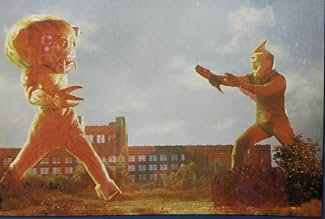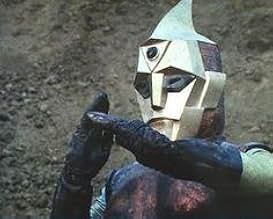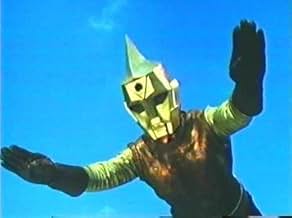Enviado por la Estrella Nebulosa para defender la Tierra, un supercyborg lucha contra los monstruos mutantes de la contaminación creados por los malvados simios espaciales Gori y Rah.Enviado por la Estrella Nebulosa para defender la Tierra, un supercyborg lucha contra los monstruos mutantes de la contaminación creados por los malvados simios espaciales Gori y Rah.Enviado por la Estrella Nebulosa para defender la Tierra, un supercyborg lucha contra los monstruos mutantes de la contaminación creados por los malvados simios espaciales Gori y Rah.
Explorar episodios
Opiniones destacadas
I blind bought this series a few years ago from a bootleg seller on ebay. It wasn't much of a risk since Ultraman is one of the earliest show I remember watching and this is a pretty good knockoff. Oddly, I now find this show a slightly more entertaining watch than Ultraman. All the shows have a environmental theme and the creatures are often hilarious! I love how the female character changes often. It's like they keep upgrading her. Heh! But I can't recommend this enough to fans. I paid about $50 for it. That's a lot, but I wasn't disappointed. Maybe BCI will release this like they did Ultraman. If the quality is equal to that release, I'd upgrade my bootlegs in a minute.
I have always liked this series. The hero Spectreman is so cool. The villains which are gorilla like but they are some time very funny. The monsters are neat and the action is very good. Back years ago it was somewhat easy to find videos of this good show but now its a different story. I really liked Spectreman and hopefully one day some company will re-release it soon!
10inkdcub
I love Spectreman. It was so much fun, Dr. Gori was cool and the monsters were all so weird. One of the best 70's Japanese superhero shows! I own a bunch of the Marmit Parababy figures from this series, and I just got the articulated Evolution Toy HAF Spectreman. I even got his tattooed on my chest. Spectreman is great fun!
Bizarre -- even by 70's Japanese "tokusatsu" (special effects series) standards, and highly entertaining. This series was produced in 1971 by P Productions, which in the mid-60's created Space Giants, a UHF TV staple of the 70's. Spectreman was, improbably, brought to US shores in 1979, eight years after its Japanese run, by Mell Welles, who was best known for his role as Gravis Mushnick in the original 1960 Little Shop of Horrors.
Like Space Giants, Spectreman would fight the same monster several times over the course of two episodes, presumably to save on monster suit costs. Also, like Space Giants, the series nemesis, Dr. Gori, was a space villain seeking to rule the earth (this time using giant "pollution monsters" as his tactic of choice) who operated from a flying saucer, wearing an exquisitely cheesy gorilla mask and blonde wig. No doubt this character was aped from Dr Zaius in Planet of the Apes, which was very popular in Japan. And, again, like Space Giants, optical effects were eschewed. Instead, P Productions used (and reused) animated sequences for transformations and various beam weapons to cut costs.
Unlike the many other transforming heroes of Japan, Spectreman was not in control of his transformation. He answers to his "overlords", an orb-like spaceship that he can't contact in cloudy weather. In some episodes he must drive to where there is no cloud cover to contact the overlords. Sometimes they will insist he transform. Sometimes he will request transformation, and will be denied. The overlords are positioned as wise overseers, similar to the "Methuselah" character in Space Giants, both of whom are prone to lecture the hero.
In re-watching the series, it seemed to get a bit of a budget boost around a 1/3 of the way into the series. The FX were incredibly threadbare in the first 10 or so episodes with most monster battles occurring in open fields. Then Spectreman started having battles in cities with building miniatures, creatures started to appear in oceans and lakes requiring access to a wet FX set, and fighter jet miniatures started being used, along with more pyrotechnics.
Overall, Spectreman is inspired early-70's Japanese cinema outre fun.
Like Space Giants, Spectreman would fight the same monster several times over the course of two episodes, presumably to save on monster suit costs. Also, like Space Giants, the series nemesis, Dr. Gori, was a space villain seeking to rule the earth (this time using giant "pollution monsters" as his tactic of choice) who operated from a flying saucer, wearing an exquisitely cheesy gorilla mask and blonde wig. No doubt this character was aped from Dr Zaius in Planet of the Apes, which was very popular in Japan. And, again, like Space Giants, optical effects were eschewed. Instead, P Productions used (and reused) animated sequences for transformations and various beam weapons to cut costs.
Unlike the many other transforming heroes of Japan, Spectreman was not in control of his transformation. He answers to his "overlords", an orb-like spaceship that he can't contact in cloudy weather. In some episodes he must drive to where there is no cloud cover to contact the overlords. Sometimes they will insist he transform. Sometimes he will request transformation, and will be denied. The overlords are positioned as wise overseers, similar to the "Methuselah" character in Space Giants, both of whom are prone to lecture the hero.
In re-watching the series, it seemed to get a bit of a budget boost around a 1/3 of the way into the series. The FX were incredibly threadbare in the first 10 or so episodes with most monster battles occurring in open fields. Then Spectreman started having battles in cities with building miniatures, creatures started to appear in oceans and lakes requiring access to a wet FX set, and fighter jet miniatures started being used, along with more pyrotechnics.
Overall, Spectreman is inspired early-70's Japanese cinema outre fun.
One of the wonders of Japanese television. Spectreman was the creation of P Productions, a low-end children's programming company. Their previous shows were animation and the Tezuka created live action Commander Magma which was released here as "Space Giants". This show is a combination of both of their departments.
Much cheaper than the similar Ultraman series, Spectreman was populated with wacky monsters, and a chief villain blue ape on the level of a Halloween rubber mask. Laser beams, rays, and other similar special effects were accomplished by animating over still photographs of the characters! The cheapness was offset by the sheer energy of the show. They kept it moving and fun.
The show was originally presented as three separate series ending up with 63 episodes. It starts as a traditional monster of the week program but it changed into a Kamden Rider / Power Rangers type format with legions of strange fighting aliens battling the hero and his friends in extended martial art battles. The giant monsters never disappear. The design is just bizarre. It's hard to tell if the monsters are lumpy and misshapen on purpose or they just didn't know how to make the suits.
Great fun but somewhat obscure now, that's too bad.
Much cheaper than the similar Ultraman series, Spectreman was populated with wacky monsters, and a chief villain blue ape on the level of a Halloween rubber mask. Laser beams, rays, and other similar special effects were accomplished by animating over still photographs of the characters! The cheapness was offset by the sheer energy of the show. They kept it moving and fun.
The show was originally presented as three separate series ending up with 63 episodes. It starts as a traditional monster of the week program but it changed into a Kamden Rider / Power Rangers type format with legions of strange fighting aliens battling the hero and his friends in extended martial art battles. The giant monsters never disappear. The design is just bizarre. It's hard to tell if the monsters are lumpy and misshapen on purpose or they just didn't know how to make the suits.
Great fun but somewhat obscure now, that's too bad.
¿Sabías que…?
- TriviaThe series was a reasonable success in Japan. When it came to the US received a good audience and the distributor changed the opening song. They made a new version using the song "The First Day of Forever" by the band The Mystic Moods Orchestra.
- ConexionesFeatured in The Creature Wasn't Nice (1981)
- Bandas sonorasSpectreman Go Go
("Supekutoruman Gô Gô")
(Main Title Theme, Episodes 1-39)
Composed & Arranged by Kunio Miyauchi
Lyrics by Yûji Amemiya
Sung by The Misuzu Children's Choir, The Honey Knights & Studio Orchestra
Selecciones populares
Inicia sesión para calificar y agrega a la lista de videos para obtener recomendaciones personalizadas
- How many seasons does Spectreman have?Con tecnología de Alexa
Detalles
- Color
Contribuir a esta página
Sugiere una edición o agrega el contenido que falta

Principales brechas de datos
By what name was Supekutoruman (1971) officially released in Canada in English?
Responda






















